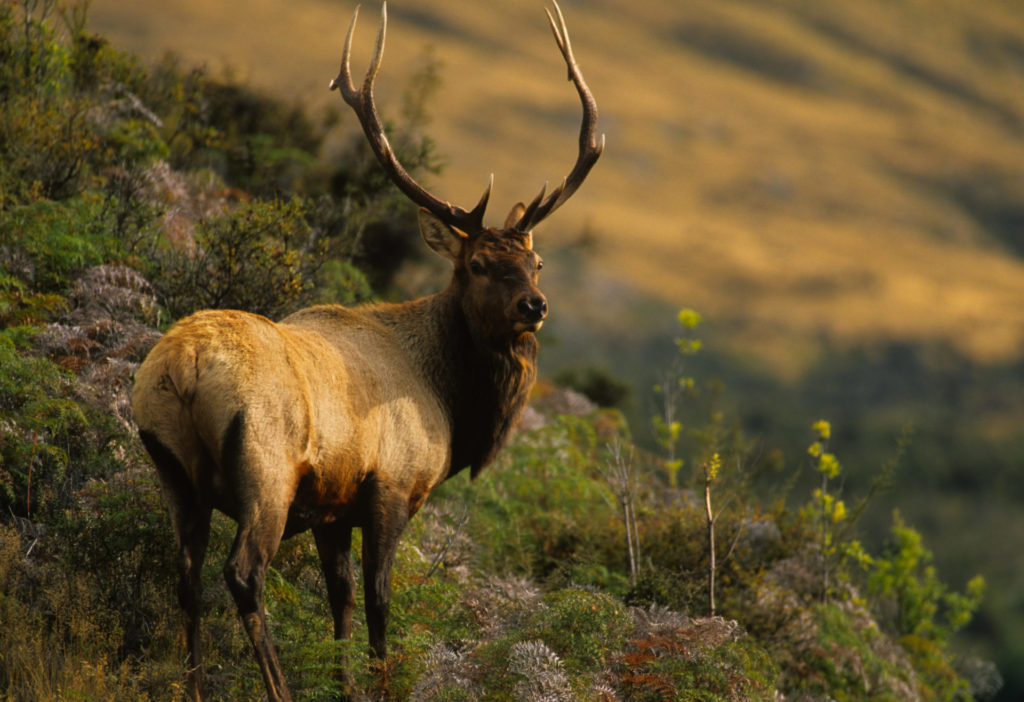In the misty and rain-soaked forests of southwestern BC, there lives a regal but secretive animal, the largest of its species, and the mature males carry truly impressive headgear.
Advertisement
Roosevelt elk, named after President Theodore Roosevelt, have a patchy distribution in the temperate rainforests from southeast Alaska to northern California. In BC, they can be found on Vancouver Island, the Sunshine Coast and the west slopes of the Coast Mountains, as well as in several tributary drainages north of the Fraser River.

North American elk are the second largest member of the deer family after moose. They have a robust body on long, slender legs. Bulls can weigh 300 to 500 kilograms and cows about two-thirds that size. Both sexes have similar pelage: a dark brown head and neck; a lighter, grey-brown body; and a distinct, creamy-white rump patch. Only bulls grow antlers, ranging in size from spikes on yearlings, to the large, branched racks of older animals. At maturity, elk antlers consist of a heavy, cylindrical main beam, sweeping up and back from the skull, with six or more well-spaced pointed tines projecting at right angles, and usually forward, from the main beam. The antler set from a big bull elk is a grand trophy.
Advertisement
Elk are relative newcomers to North America, although the fossil history goes back a million years to the dry hills of southwestern Asia. During the ice ages, the most recent of which receded only about 10,000 years ago, a broad isthmus of grassland connected Asia and North America where the shallow Bering Sea is now. Asian elk found a toehold in the ice-free areas of Alaska and expanded their range in North America as the continental glaciers melted. Dense, coniferous forests gradually came to dominate the landscape of Alaska and Alaskan elk disappeared. Further south, though, elk eventually colonized much of the rest of the continent.
At one time, there were six subspecies of elk in North America. Two are now basically extinct: eastern elk, which were found in Ontario, Quebec and eastern USA, and Merriam’s elk, which was restricted to the mountains of Arizona and northern Mexico. California’s Tule elk are not extinct, but they are no longer widely distributed in that state. Manitoba elk were once found in large numbers on the Great Plains from Saskatchewan to Texas, but they now thrive only in pockets within their former Canadian range.
Advertisement
Healthy populations of Roosevelt elk still inhabit the coastal mountains and forests of western North America. However, Rocky Mountain elk are by far the most successful of the original six subspecies and are still found in very good numbers from northern BC south to Colorado. Roosevelt elk are the largest surviving subspecies of elk in body size, although Rocky Mountain elk bulls may grow larger antlers.

Roosevelt elk have smaller home ranges and prefer denser cover than do other elk subspecies. They behave a bit like white-tailed deer, staying close to cover and becoming extra wary, withdrawing to even thicker cover if pressured by hunters or other human activity.
The preferred habitat of Roosevelt elk in BC is limited to west of the Coast Mountains and they likely never were really common in this province. By the mid 1900s, though, overhunting and habitat loss had reduced even those numbers, until they were basically found only in dispersed pockets on Vancouver Island. However, starting 1978, a series of translocations expanded their range on the Island and established new elk herds on parts of the Sunshine Coast. The translocations to the mainland have been very successful, to the point that some have become the source herds for further releases elsewhere in the Lower Mainland Region. Almost 1,000 Roosevelt elk have been moved to new homes and the provincial population is now estimated at 7,000. Elk are now found the upper valleys of the major rivers north of the Fraser, from Squamish River to Harrison Lake. Their numbers are trending up and they are now colonizing new areas on their own. The best elk numbers are in the more remote areas, away from road access and the accompanying negative human activity.
Recovering Roosevelt elk populations in BC is a good-news wildlife management story. Although their population is lower, and their range is smaller and more fragmented than historically, many misty mountain slopes and rugged coastal valleys are again home to this majestic big game animal.